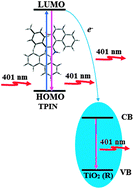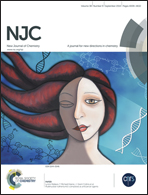Binding and fluorescence enhancing behaviour of phenanthrimidazole with different phases of TiO2
Abstract
Photoinduced intramolecular charge transfer (ICT) in a series of a newly synthesized 1H-phenanthro[9,10-d]imidazoles containing electron donor–acceptor fragments have been studied. The effect of solvents on the fluorescence spectra indicates the CT character of emitting singlet states and analysis of CT fluorescence accounts the electron transfer in the Marcus inverted region. Nanocrystalline anatase and rutile phases of TiO2 were obtained by the sol–gel method, characterized by X-ray diffraction, high resolution scanning electron microscopy, transmission electron microscopy and energy dispersive, UV-visible diffuse reflectance, and solid photoluminescence spectroscopies. TiO2 Hombikat was supplied by fluka. TiO2 P25 was a gift from Degussa. Absorption, fluorescence and lifetime spectral studies, and cyclic voltammetric analysis have been employed to investigate the interaction of TPIN with TiO2 (A), TiO2 (H), TiO2 (P25) and TiO2 (R). The fluorescence of TPIN is efficiently quenched by TiO2 (A), TiO2 (H) and TiO2 (P25) nanoparticles owing to charge injection from the excited singlet state of TPIN to the conduction band of the TiO2 nanoparticles. However, TiO2 (R) enhances the fluorescence due to lowering of LUMO and HOMO levels of TPIN.


 Please wait while we load your content...
Please wait while we load your content...